Click on images to enlarge

habit (Photo: Sheldon Navie)
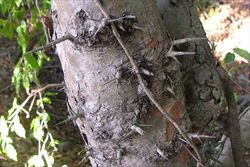
trunk with branched spines (Photo: Sheldon Navie)
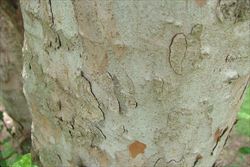
older trunk with flaky bark, it has also lost its spines (Photo: Sheldon Navie)
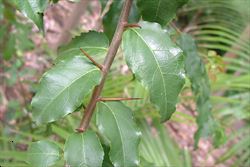
younger stem with unbranched spines (Photo: Sheldon Navie)
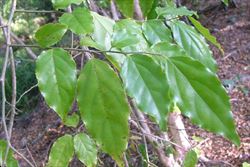
leaves with shiny upper surfaces (Photo: Sheldon Navie)
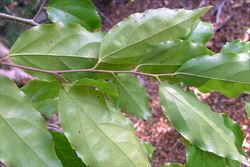
paler leaf undersides (Photo: Sheldon Navie)
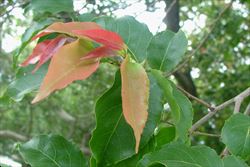
pinkish-coloured young leaves (Photo: Sheldon Navie)
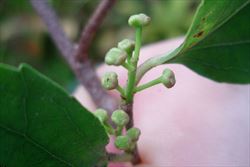
young male flowers (Photo: Robert Whyte)
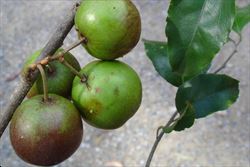
immature fruit (Photo: Matthew Tomkins)
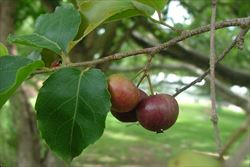
mature fruit (Photo: Sheldon Navie)
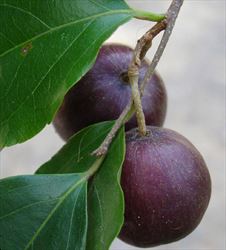
close-up of mature fruit (Photo: Matthew Tomkins)
Scientific Name
Flacourtia jangomas (Lour.) Raeusch.
Synonyms
Flacourtia cataphracta Roxb. ex Willd.Stigmarota jangomas Lour.
Family
Flacourtiaceae
Common Names
coffee plum, flacourtia, Indian cherry, Indian plum, Indian-plum
Origin
Possibly indigenous to tropical Asia. Not known in the wild, but it may have originated in India (i.e. in the area of Assam) or Myanmar.
Cultivation
Indian plum (Flacourtia jangomas) is occasionally cultivated in the warmer parts of Australia, usually as a "rare and exotic" fruit tree.
Naturalised Distribution
This species is naturalised in the warmer coastal districts of eastern Australia. It most common in northern Queensland (e.g. in the Daintree, Mossman, El Arish, Proserpine and Murray Island areas), but is also naturalised in central and south-eastern Queensland (particularly around Brisbane).
Naturalised overseas in New Caledonia and the Cook Islands in the Pacific Ocean, and on La Réunion in the Mascarenes.
Habitat
A weed of waterways (i.e. riparian habitats), closed forests, roadsides, disturbed sites and waste areas in wetter tropical and sub-tropical regions.
Habit
A small tree that loses its leaves during winter (i.e. it is deciduous). It usually grows 6-10 m tall, but may occasionally reach up to 14 m in height.
Distinguishing Features
- a small tree usually with greyish or pale brown flaky bark.
- its trunk and branches bear sharp spines, and these spines are often branched.
- its glossy green leaves have pointed tips and toothed margins.
- separate male and female flowers are borne on different trees.
- its rounded fleshy fruit (15-25 mm across) turn dark red to nearly black in colour when mature.
Stems and Leaves
The trunks and branches are commonly thornless when old, but are usually densely armed with simple or branched woody thorns when they are younger. The bark varies from light-brown or grey to copper-red or pinkish-buff in colour, and flakes off in thin scales. Younger branches are covered in white raised dots (i.e. lenticels) and are mostly or entirely hairless (i.e. puberulous or glabrous).
The leaves are narrowly egg-shaped to oblong in shape (i.e. narrowly-ovate to ovate-oblong) and usually have pointed tips (i.e. acute or acuminate apices). These leaves (5-11 cm long and 2-5.5 cm wide) are hairless (i.e. glabrous) with toothed (i.e. serrate to crenate) margins. Their upper surfaces are glossy while their undersides are mostly dull in appearance. Young leaves are usually pinkish or a light cinnamon-brown colour. The leaves are borne on a short stalk (i.e. petiole) 6-8 mm long and are alternately arranged along the stems.
Flowers and Fruit
The flowers are borne in few-flowered clusters in the leaf forks (i.e. in axillary racemes). Separate male and female (i.e. unisexual) flowers are produced, and these are borne on separate plants (i.e. this species is dioecious). These flowers are fragrant and are usually produced before or with the first leaves in spring. The male flower clusters (15-30 mm long) consist of a few rounded flowers that are borne on slender stalks (i.e. pedicels) 5-15 mm long. Each male (i.e. staminate) flower has four (or occasionally five) tiny greenish sepals (about 2 mm long) that are relatively broad with rounded tips (i.e. ovate with obtuse apices). These male flowers do not have any petals, but they have numerous spreading yellow stamens. The female (i.e. pistillate) flower clusters (10-15 mm long) also consist of a few flowers with similar sepals to the male flowers. These female flowers also lack petals, but they have a flask-shaped to almost rounded (i.e. sub-globular) ovary with 4-6 styles that are fused together for the most part. Each of these styles bears a two-lobed, recurved, stigma at its tip.
The fruit (15-25 mm across) are rounded (i.e. sub-globose) berries that turn from green to dull-brownish red or dark purple in colour as they mature (they may eventually become blackish when fully mature). These fruit are fleshy (i.e. succulent) with a greenish-yellow pulp that usually contains 4 or 5 (occasionally up to 10) flatenned seeds (up to 10 mm long and 7 mm wide).
Reproduction and Dispersal
This species reproduces only by seed. The seeds may be spread in floods, but are most commonly dispersed by animals that eat the fruit.
Environmental Impact
Indian plum (Flacourtia jangomas) is regarded as an environmental weed in Queensland. It is currently of most concern in far northern Queensland, where it is invading rainforests, forest margins and riparian areas in the wet tropics bioregion. This species is listed as a Category 1 priority environmental weed in the Far North Queensland Natural Resource Management region, and has been targeted for eradication in this area.
Indian plum (Flacourtia jangomas) is still thought to be in the early stages of invasion, often being referred to as a "sleeper weed". It is a relatively slow-growing tree and small numbers of plants are thought to be present in naturalised populations. However, it is not very conspicuous and may be more widespread and common than currently thought. Its seeds are also spread birds or other animals and new plants may come up at some distance from parent trees or in areas where they are not likely to be noticed.
Though this species has not yet necessarily caused serious ecological damage, Indian plum (Flacourtia jangomas) is recognised as potentially adversely impacting upon high value natural ecosystems in northern Queensland (i.e. the Wet Tropics World Heritage Area). It has also begun to invade riparian zones in south-eastern Queensland (e.g. along Enoggera Creek in The Gap in suburban Brisbane) and is regarded as a moderately invasive species in the Cook Islands in the south Pacific.
Other Impacts
The spines on its stems may cause injury to humans and animals. If dense infestations eventually develop along riparian zones, they may restrict access to these areas.
Legislation
Not declared or considered noxious by any state government authorities.
Similar Species
Indian plum (Flacourtia jangomas) is very similar to Governor's plum (Flacourtia indica). These two species are both naturalised in Australia, and can be distinguished by the following differences:
- Indian plum (Flacourtia jangomas) has hairless (i.e. glabrous) leaves with long-pointed tips (i.e. acuminate apices).
- Governor's plum (Flacourtia indica) has somewhat hairy (i.e. pubescent) leaves with rounded or short-pointed tips (i.e. obtuse or acute apices).
Honey locust (Gleditsia triacanthos), another introduced tree, often has similar branched spines on its stems. However, this species has compound (i.e. pinnate or bipinnate) leaves and very large elongated pods (15-45 cm long).

